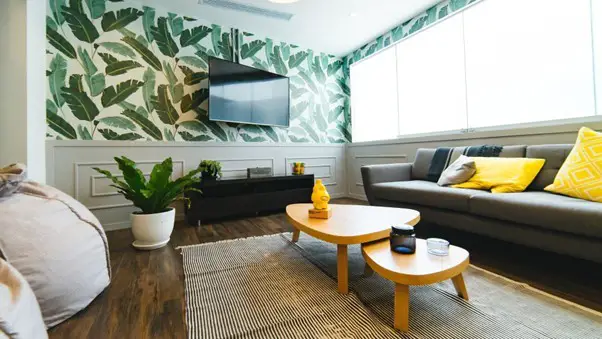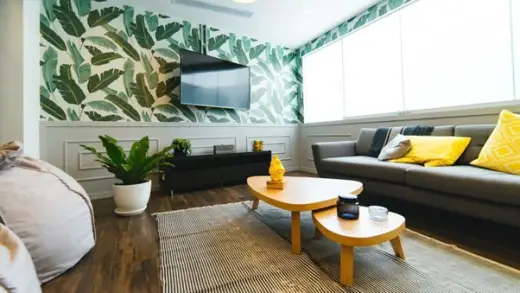Exploring the art of sofa placement guide, Home furniture placing advice, Property interior decor style tips
Exploring the Art of Sofa Placement
30 June 2023
A well-placed sofa can transform the entire ambiance of a living room. It not only provides a comfortable spot for relaxation and socialising but also serves as a focal point that sets the tone for the entire space. The positioning of your sofa plays a bigger role than you might think in creating a cosy and functional environment while doing the best for the visual appeal of your living area.
Whether you’re looking to optimise space utilisation, create distinct zones, or simply enhance the overall aesthetics, discover how to strike the perfect balance between comfort, functionality, and style.
Exploring the Art of Sofa Placement at Home
Against the wall
Placing the sofa against a wall is a classic arrangement that works well in many living rooms. This position gives you the most floor space, especially in smaller areas, and creates an open flow through the room. It also provides a clear focal point, such as a TV or fireplace, if positioned opposite. However, it’s important to consider the depth of the sofa and ensure that it doesn’t appear too cramped or disconnected from the rest of the furniture.
Floating in the room
In larger spaces, you have the freedom to position the sofa away from the walls, creating a more open and spacious feel. This arrangement is particularly useful when you want to create multiple conversation areas or have a large gathering. By placing the sofa in the centre of the room, you can create a cohesive and inviting atmosphere. However, keep in mind that floating the sofa might require additional consideration for wiring, access to outlets, and creating a visually pleasing arrangement from all angles.
Corner placement
Corner placement can transform a corner of a room into a cosy seating nook. By positioning the sofa in a corner, you can create a sense of enclosure and intimacy. This arrangement works well in smaller spaces where you want to optimise every inch of usable area. It also allows you to add additional seating options, such as chairs or a loveseat, to create a comfortable gathering spot.
Dividing a room
In open floor plans, it can be challenging to create distinct zones for different activities. Placing the sofa strategically can help define and separate areas. For example, positioning the sofa perpendicular to other furniture or walls can act as a visual divider between the living room and dining area. This arrangement maintains an open feel while still giving each space its own identity. Just make sure to consider the overall flow and functionality of the room to avoid obstructing movement.
L-shaped or sectional sofa configuration
L-shaped or sectional sofas offer great flexibility in terms of positioning. They can adapt to various room shapes and sizes. If you have a larger living room, placing an L-shaped or sectional sofa against the walls can create a sense of structure and anchor the seating area. Alternatively, you can position it in the centre of the room, facing a focal point, to make a statement and allow for easy conversation. These configurations also provide ample seating, making them ideal for large families or frequent entertainers.
Angled placement
Angling the sofa in the room can add visual interest and break away from the traditional linear arrangements. By placing the sofa at an angle, you introduce a dynamic and stylish element to the space. It can create a sense of movement and flow, particularly in rooms with square or rectangular layouts. However, it’s crucial to consider the flow of the room and how the angled position might impact other furniture or traffic patterns. Ensure that there’s enough space for easy movement around the angled sofa without making the room feel cluttered.
What about sofa height?
The height of the sofa feet can affect the visual perception of your sofa. Higher feet can create a sense of openness and lightness, making the sofa appear more elevated and spacious. On the other hand, lower feet can create a grounded and substantial look, giving the sofa a solid and stable presence in the room.
By elevating the sofa off the floor, light can pass underneath, creating a sense of openness and making the room feel larger too. This can be particularly advantageous in smaller spaces where you want to maximise the perception of roominess.
Higher feet allow for better access to vacuum or sweep underneath the sofa, making it simpler to maintain cleanliness.
Home furniture placing tips
Final Thoughts
Remember to consider the overall layout of the room, natural light sources, focal points, and traffic flow when determining the best sofa position. Experimenting with different arrangements can help you find the perfect balance between comfort, functionality, and aesthetics in your living space.
Comments on this guide to Exploring the art of sofa placement article are welcome.
Glasgow Housing Designs
Contemporary Glasgow Residential Property Designs – selection:
249 West George Street Glasgow student flats
The Foundry Cathcart housing development
Comments / photos for the Exploring the art of sofa placement in your property – House furniture placing ideas guide page welcome




